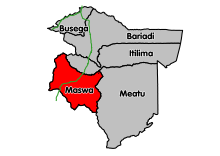Maswa (district)
| Maswa District | |
|---|---|
 Location of the Maswa District in Tanzania |
|
| Basic data | |
| Country | Tanzania |
| region | Simiyu |
| surface | 3398 km² |
| Residents | 344,125 (2012) |
| density | 101 inhabitants per km² |
| ISO 3166-2 | TZ-30 |
Coordinates: 2 ° 41 ′ S , 33 ° 42 ′ E
Maswa is a district in the Tanzanian region of Simiyu with the administrative center in the city of Maswa . The district is bordered to the north by the district Itilima , on the east by the district Meatu and to the south and to the west by the region Mwanza .
geography
Maswa is 3,398 square kilometers and has around 344,000 inhabitants (as of 2012) and is the southwesternmost district of the Simiyu region. It is between 1200 and 1300 meters above sea level. The climate is semi-arid, it rains between 450 and 1000 millimeters per year. Precipitation decreases from north to south and from west to east. They fall in two rainy seasons, shorter showers from mid-November to mid-January, longer rains in March, April and May. The average temperature is 26 degrees Celsius. Large areas are only sparsely overgrown, the soil fertility is below average.
history
Maswa was founded as a separate district in 1977. In 2012, the district moved from Shinyanga region to Simiyu region.
Administrative division
The district is divided into the three districts (divisions) Mwagala , Sengerema and Nung'hu and 26 parishes (wards):
- Badi
- Binza
- Buchambi
- Budekwa
- Busilili
- Dakama
- Ipililo
- Isanga
- Kadoto
- Kulimi
- Lalago
- Malampaka
- Masela
- Mpindo
- Mwamanenge
- Mwamashimba
- Mwang'honoli
- Nguliguli
- Ng'wigwa
- Nyabubinza
- Nyalikungu
- Senani
- Seng'wa
- Shishiyu
- Sukuma
- Zanzui
populationThe largest ethnic group in Maswa are the Sukuma , but there are also Waha , Nyilamba, Nyantuzu and Kurya. From 2002 to 2012 the population increased by thirteen percent, with the increase in rural areas being greater, while the population in urban areas decreased slightly. Of those over five years of age, 56 percent could read and write Swahili and seven percent English and Swahili, 37 percent were illiterate (as of 2012). |
 |
Facilities and services
- Education: There are 123 primary schools in the district, 121 of which are public and two are private schools. Of the 40 secondary schools, 36 are public and 4 are private. There are also three higher schools, two of which are privately run.
- Health: Maswa has three health centers and 42 pharmacies.
- Water: Sixty percent of the rural population and 83 percent of those living in urban areas have access to clean water. The supply varies greatly from one location to the next, with Ipililo and Zebeya having a supply rate of 83 percent, but Mwang'holo only thirteen percent.
Economy and InfrastructureOf the total area of 3398 square kilometers, 2,475 square kilometers are suitable for agriculture, 77 square kilometers are forest, the rest is rocky area with bush cover. Of those over ten years of age, 64 percent were employed, thirteen percent worked in the household (cooking, hygiene, care), seventeen percent in training, three percent unemployed and three percent unable to work (as of 2012).
|
 |
Web links |
 |
Individual evidence
- ↑ a b c d Regional Newsletter, Simiyu Region. (PDF) The United Republic of Tanzania, pp. 7–8 , accessed on November 11, 2019 (Swahili).
- ↑ a b Maswa District Council Strategic Plan 2016 / 2017-2020 / 2021. (PDF) November 2017, pp. 1–2 , accessed on November 11, 2019 .
- ↑ Maswa District Council Strategic Plan 2016 / 2017-2020 / 2021. (PDF) November 2017, p. 5 , accessed on November 11, 2019 .
- ^ Tanzania Regions. Retrieved November 11, 2019 .
- ↑ Tanzania: Lake Zone (Districts and Wards) - Population Statistics, Charts and Map. Retrieved November 11, 2019 .
- ↑ Maswa District Council Strategic Plan 2016 / 2017-2020 / 2021. (PDF) November 2017, p. 4 , accessed on November 11, 2019 .
- Jump up ↑ Tanzania Regional Profiles, 24 Simiyu Regional Profiles. (PDF) The United Republic of Tanzania, 2016, pp. 16–17, 72 , accessed on November 8, 2019 .
- ↑ a b Category publications | Simiyu region. (PDF) The United Republic of Tanzania, pp. 7–8 , accessed on November 11, 2019 .
- ^ The Whole Village Project. (PDF) University of Minnesota, February 2011, p. 9 , accessed November 11, 2019 .
- ↑ a b Agriculture. Retrieved November 11, 2019 .
- Jump up ↑ Tanzania Regional Profiles, 24 Simiyu Regional Profiles. (PDF) The United Republic of Tanzania, 2016, p. 94 , accessed on November 8, 2019 .
- Jump up ↑ Tanzania Regional Profiles, 24 Simiyu Regional Profiles. (PDF) The United Republic of Tanzania, 2016, pp. 129, 131 , accessed on November 8, 2019 .
- ↑ Maswa District Council Strategic Plan 2016 / 2017-2020 / 2021. (PDF) November 2017, p. 10 , accessed on November 11, 2019 .
- ^ Trunk Roads Network. (PDF) Retrieved November 11, 2019 .
